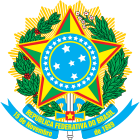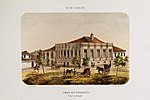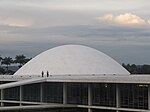Brazilian Senate
Federal Senate Senado Federal | |
|---|---|
| 56th Legislature of the National Congress | |
 | |
| Type | |
| Type | |
Term limits | None |
| History | |
| Founded | May 6, 1826 |
New session started | February 1, 2021 |
| Leadership | |
Government Leader | |
Majority Leader | Renan Calheiros, MDB since 4 February 2021 |
Opposition Leader | |
Minority Leader | Jean-Paul Prates, PT since 4 February 2021 |
Female Caucus Leader | Simone Tebet, MDB since 9 March 2021 |
| Structure | |
| Seats | 81 |
 | |
Political groups | Government (11)[1]
Confidence & Supply (53)[1] Opposition (17)[1] |
Length of term | 8 years |
| Elections | |
Voting system | Plurality voting, alternating every four years between single-member elections (FPTP) and dual-member elections (block voting) |
Last election | October 7, 2018 |
Next election | October 2, 2022 |
| Meeting place | |
 | |
| Senate plenary chamber National Congress building Brasília, Federal District, Brazil | |
| Website | |
| http://www.senado.gov.br | |
 |
|---|
|
Coordinates: 15°47′59″S 47°51′51″W / 15.79972°S 47.86417°W
The Federal Senate (Portuguese: Senado Federal) is the upper house of the National Congress of Brazil. When created within the Brazilian Empire in 1824, it was based on the British House of Lords, but since the Proclamation of the Republic in 1889 the Federal Senate has resembled the United States Senate. In its current form the Senate has 81 seats, three each for the Federal District and the 26 states. Senators sit for eight years, and elections are staggered so that either a third or two-thirds are up for election every four years.
The current president of the Brazilian Senate is Rodrigo Pacheco, from the Democrats of Minas Gerais. He was elected in early 2021 for a two-year term.
Membership[]
The Senate has 81 members, serving an eight-year term of office. There are three Senators from each of the country's 27 federative units, the Federal District and the 26 states. Elections are staggered so that either a third or two-thirds of Senators are up for election every four years. The most recent election took place in 2018, where two-thirds of the Senate was elected.
Electoral system[]
Elections are held under the first-past-the-post and block voting systems. In years when a third of members are up for election, voters can cast only one vote and the candidate who receives a plurality of votes within their state is elected. In years when two-thirds of members are up for election, voters can cast two votes. People can not vote for the same candidate twice, but each party can field up to two candidates in each state. The two highest-placed candidates in each state are elected.
History[]
The Federal Senate of Brazil was established as the Senate of the Empire by the Constitution of 1824, first enacted after the Declaration of Independence. It was modelled on the British House of Lords.[2]
Following independence, in 1822, Emperor Pedro I ordered the convocation of a National Assembly to draft the country's first Constitution. Following several disagreements with the elected deputies (which included representatives from present-day Uruguay, then part of the Brazilian Empire under the name of Província Cisplatina), the Emperor dissolved the Assembly. In 1824, Pedro I implemented the first Constitution which established a Legislative branch with the Chamber of Deputies as the lower house, and the Senate as an upper house.
The first configuration of the Senate was a consulting body to the Emperor. Membership was for life and it was a place of great prestige, to which only a small part of the population could aspire. The original Senate had 50 members, representing all of the Empire's provinces, each with a number of senators proportional to its population.
Members of the Senate were elected, but they had to be at least 40 years old and have an annual income of 800,000 contos-de-réis, which limited candidates to wealthy citizens. Voters also faced an income qualification. Voting in an election for the Senate was limited to male citizens with an annual income of at least 200,000 contos-de-réis. Those who qualified for this did not vote directly for Senators; instead, they voted for candidates to be Senate electors. To be a Senate elector required an annual income of 400,000 contos-de-réis. Once elected, these electors would then vote for senator. The election itself would not result in a winner automatically. The three candidates receiving the most votes would make up what was called a "triple list", from which the Emperor would select one individual that would be considered "elected". The Emperor usually chose the candidate with the most votes, but it was within his discretion to select whichever of the three individuals listed. The unelected Princes of the Brazilian Imperial House were senators by right and would assume their seats in the Senate upon reaching age 25.
Following the adoption of the 1824 Constitution the first session of the Senate took place in May 1826. The Emperor had repeatedly delayed calling the first election, which had led to accusations that he would attempt to establish an absolutist government.
The Proclamation of the Republic in 1889 ended the Brazilian Empire in favor of the First Republic. The 1891 Constitution was then adopted, transforming Brazil's provinces into states and the Senate into an elected body. This was retained under later constitutions, including the current 1988 Constitution. Now known as the Federal Senate, it resembles the United States Senate in that each state has the same number of Senators.

Palácio Conde dos Arcos, seat of the Imperial Senate in Rio de Janeiro, then Brazil's capital.

Palácio Monroe, second seat of the Senate.

The Federal Senate in the National Congress building in Brasília, capital city of Brazil since 1960.
Exterior view of the Senate chamber.
Director Board[]
The current composition of the Board of the Federal Senate is as follows:
| Office | Name | Party | State |
|---|---|---|---|
| President | Rodrigo Pacheco | DEM | Minas Gerais |
| 1st Vice-President | Veneziano Vital do Rêgo | MDB | Paraíba |
| 2nd Vice-President | Romário Faria | PODE | Rio de Janeiro |
| 1st Secretary | Irajá Abreu | PSD | Tocantins |
| 2nd Secretary | Elmano Férrer | PP | Piauí |
| 3rd Secretary | Rogério Carvalho | PT | Sergipe |
| 4th Secretary | Weverton Rocha | PDT | Maranhão |
| 1st Substitute | Jorginho Mello | PL | Santa Catarina |
| 2nd Substitute | Luiz do Carmo | MDB | Goiás |
| 3rd Substitute | Eliziane Gama | CDN | Maranhão |
| 4th Substitute | Zequinha Marinho | PSC | Pará |
Composition[]
Leadership[]
The current composition[3] of the House (56th Legislature) is as follows:
| Party | Floor leader | Seats | % of seats | |
|---|---|---|---|---|
| Brazilian Democratic Movement | Eduardo Braga | 15 | 18.52% | |
| Social Democratic | Nelsinho Trad | 11 | 13.58% | |
| Podemos | Alvaro Dias | 9 | 11.11% | |
| Brazilian Social Democracy | Roberto Rocha | 7 | 8.64% | |
| Progressistas | Daniella Ribeiro | 7 | 8.64% | |
| Democrats | Marcos Rogério | 6 | 7.41% | |
| Workers' | Paulo Rocha | 6 | 7.41% | |
| Cidadania | Alessandro Vieira | 3 | 3.70% | |
| Democratic Labour | Weverton Rocha | 3 | 3.70% | |
| Liberal | Carlos Portinho | 3 | 3.70% | |
| Republican Party of the Social Order | Telmário Mota | 3 | 3.70% | |
| Republicanos | Mecias de Jesus | 2 | 2.47% | |
| Sustainability Network | Randolfe Rodrigues | 2 | 2.47% | |
| Brazilian Socialist | Leila Barros | 1 | 1.24% | |
| Social Christian | Zequinha Marinho | 1 | 1.24% | |
| Social Liberal | Soraya Thronicke | 1 | 1.24% | |
| Total | 81 | 100.0% | ||
Current Senators[]
|
|
|
Standing committees[]
| Committee | Chair |
|---|---|
| Agriculture and Agrarian Reform | Acir Gurgacz (PDT-RO) |
| Constitution, Justice and Citizenship | Davi Alcolumbre (DEM-AP) |
| Economic Affairs | Otto Alencar (PSD-BA) |
| Education, Culture and Sports | Marcelo Castro (MDB-PI) |
| Environment | Jaques Wagner (PT-BA) |
| Ethics and Parliamentary Decorum | Jayme Campos (DEM-MT) |
| Foreign Affairs and National Defence | Kátia Abreu (PP-TO) |
| Human Rights and Participative Legislation | Humberto Costa (PT-PE) |
| Infrastructure Services | Dário Berger (MDB-SC) |
| Regional Development and Tourism | Fernando Collor (PROS-AL) |
| Science, Technology, Innovation, Communication and Computing | Rodrigo Cunha (PSDB-AL) |
| Social Affairs | Sérgio Petecão (PSD-AC) |
| Transparency, Governance, Inspection and Control and Consumer Defence | José Reguffe (PODE-DF) |
See also[]
- Federal institutions of Brazil
References[]
- ^ Jump up to: a b c "A configuração da Câmara após a investida de Bolsonaro". Nexo (in Portuguese). Retrieved 2020-06-15.
- ^ "Senado Federal completa hoje 185 anos". R7 (in Portuguese). 6 May 2011. Retrieved 22 May 2012.
O Senado Federal foi criado com a primeira Constituição do Império, outorgada em 1824, inspirado, primeiramente, na Câmara dos Lordes da Grã-Bretanha. Sua primeira reunião ocorreu em 6 de maio de 1826.
. - ^ "Lideranças Parlamentares" (in Portuguese). Senado Federal. Retrieved 17 March 2017.
External links[]
- Official website of the Brazilian Senate
- (in Portuguese) Photos 360° of the Brazilian Senate
- List of all Brazilian senators (1826–2011; in Portuguese)
- National upper houses
- 1824 establishments in Brazil
- Federal Senate





